
Apollo 13 was the seventh crewed mission in the Apollo space program and the third meant to land on the Moon. The craft was launched from Kennedy Space Center on April 11, 1970, but the lunar landing was aborted after an oxygen tank in the service module (SM) ruptured two days into the mission, disabling its electrical and life-support system. The crew, supported by backup systems on the lunar module (LM), instead looped around the Moon in a circumlunar trajectory and returned safely to Earth on April 17. The mission was commanded by Jim Lovell, with Jack Swigert as command module (CM) pilot and Fred Haise as lunar module (LM) pilot. Swigert was a late replacement for Ken Mattingly, who was grounded after exposure to rubella.

The Space Shuttle program was the fourth human spaceflight program carried out by the U.S. National Aeronautics and Space Administration (NASA), which accomplished routine transportation for Earth-to-orbit crew and cargo from 1981 to 2011. Its official name, Space Transportation System (STS), was taken from a 1969 plan for a system of reusable spacecraft of which it was the only item funded for development. It flew 135 missions and carried 355 astronauts from 16 countries, many on multiple trips.
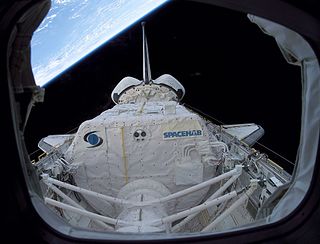
STS-107 was the 113th flight of the Space Shuttle program, and the 28th and final flight of Space Shuttle Columbia. The mission ended on February 1, 2003, with the Space Shuttle Columbia disaster which killed all seven crew members and destroyed the space shuttle. It was the 88th post-Challenger disaster mission.

The Lyndon B. Johnson Space Center (JSC) is NASA's center for human spaceflight in Houston, Texas, where human spaceflight training, research, and flight control are conducted. It was renamed in honor of the late US president and Texas native, Lyndon B. Johnson, by an act of the United States Senate on February 19, 1973.

STS-5 was the fifth NASA Space Shuttle mission and the fifth flight of the Space Shuttle Columbia. It launched on November 11, 1982, and landed five days later on November 16, 1982. STS-5 was the first Space Shuttle mission to deploy communications satellites into orbit, and the first officially "operational" Space Shuttle mission.

John Watts Young was an American astronaut, naval officer and aviator, test pilot, and aeronautical engineer. He became the ninth person to walk on the Moon as commander of the Apollo 16 mission in 1972. He is the only astronaut to fly on four different classes of spacecraft: Gemini, the Apollo command and service module, the Apollo Lunar Module and the Space Shuttle.

David Randolph Scott is an American retired test pilot and NASA astronaut who was the seventh person to walk on the Moon. Selected as part of the third group of astronauts in 1963, Scott flew to space three times and commanded Apollo 15, the fourth lunar landing; he is one of four surviving Moon walkers and the only living commander of a spacecraft that landed on the Moon.

The Rogers Commission Report was written by a Presidential Commission charged with investigating the Space Shuttle Challenger disaster during its 10th mission, STS-51-L. The report, released and submitted to President Ronald Reagan on June 9, 1986, both determined the cause of the disaster that took place 73 seconds after liftoff, and urged NASA to improve and install new safety features on the shuttles and in its organizational handling of future missions.

The Columbia Accident Investigation Board (CAIB) was an internal commission convened by NASA to investigate the destruction of the Space Shuttle Columbia during STS-107 upon atmospheric re-entry on February 1, 2003. The panel determined that the accident was caused by foam insulation breaking off from the external fuel tank, forming debris which damaged the orbiter's wing, and that the problem of "debris shedding" was well known but considered "acceptable" by management. The panel also recommended changes that should be made to increase the safety of future shuttle flights. The CAIB released its final report on August 26, 2003.
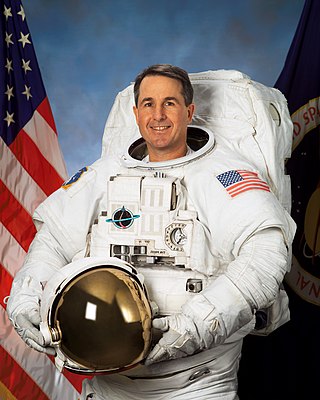
Stephen Kern "Steve" Robinson is an American former NASA astronaut.

Thomas Otten Paine was an American engineer, scientist and advocate of space exploration, and was the third Administrator of NASA, serving from March 21, 1969, to September 15, 1970.
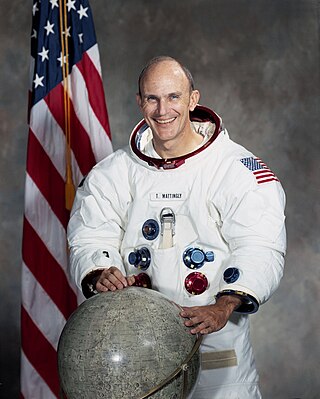
Thomas Kenneth Mattingly II was an American aviator, aeronautical engineer, test pilot, rear admiral in the United States Navy, and astronaut who flew on Apollo 16 and Space Shuttle STS-4 and STS-51-C missions.

Anthony Wayne "Tony" England is an American former NASA astronaut. Selected in 1967, England was among a group of astronauts who served as backups during the Apollo and Skylab programs. Like most others in his class, he flew during the Space Shuttle program, serving as a mission specialist on STS-51-F in 1985. He has logged more than 4,000 hours of flying time and 188 hours in space.
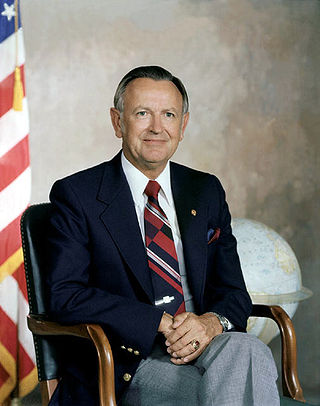
Christopher Columbus Kraft Jr. was an American aerospace and NASA engineer who was instrumental in establishing the agency's Mission Control Center and shaping its organization and culture. His protégé Glynn Lunney said in 1998: "the Control Center today ... is a reflection of Chris Kraft".
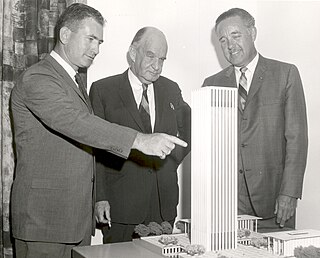
The Electronics Research Center (ERC) was a NASA research facility located in Cambridge, Massachusetts, across the street from MIT at Kendall Square. The ERC opened in September 1964 as the successor to the North Eastern Operations Office, which opened in July 1962. The Centre took over the administration of contracts, grants, and other NASA business in New England previously housed at the North Eastern Operations Office, and was closed in June 1970. Its former campus is now the site of the United States Department of Transportation's John A. Volpe National Transportation Systems Center.

John Dennis Hodge was a British aerospace engineer. He worked for the CF-105 Avro Arrow jet interceptor project in Canada. When it was cancelled in 1959, he became a member of NASA's Space Task Group, which later became the Johnson Space Center. During his NASA career, he worked as a flight director and planner. As the on-shift flight director of the Gemini 8 spaceflight crewed by Neil Armstrong and Dave Scott as it entered a spin, Hodge was credited with the safe landing of these astronauts.

Edgar Maurice Cortright was a scientist and engineer, and senior official at the National Aeronautics and Space Administration (NASA) in the United States. His most prominent positions during his career were Director of NASA's Langley Research Center, and Chairman of the Apollo 13 Review Board which investigated the explosion that occurred during the Apollo 13 spaceflight in 1970.

G. Scott Hubbard is a physicist who has been engaged in space-related research as well as program, project and executive management for more than 45 years including 20 years with NASA, culminating as director of NASA's Ames Research Center. As of 2012, Hubbard chairs SpaceX Safety Advisory Panel, he previously served as the NASA representative on the Columbia Accident Investigation Board, was NASA's first Mars program director and restructured the Mars program in the wake of mission failures.
Vernon Leslie Grose is an American author, professor, aerospace engineer, air disaster analyst, risk management expert, and former member of the National Transportation Safety Board (NTSB). In 1969, he was appointed to NASA's Safety Advisory Group for Space Flight. In 1974, he was honored with NASA's Silver Snoopy Award, presented by Brigadier General Thomas P. Stafford, veteran astronaut of the Gemini 6A, Gemini 9A, and Apollo 10 space programs.

















